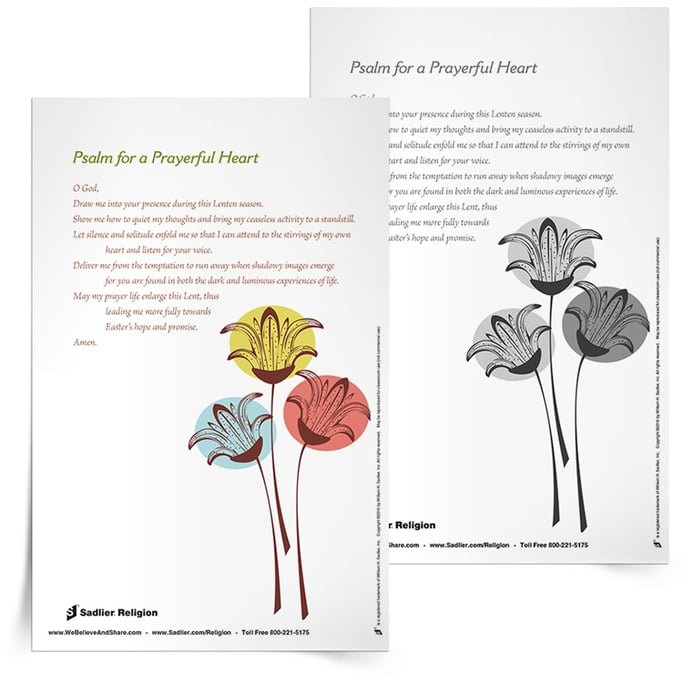March 15, 2017 WBAS Seasonal Lent, REL Seasons - Lent, REL PD - Adult Faith
“Lent is a time of spring cleaning through intensifying our prayer life, fasting from food or bad habits, and performing acts of charity and justice.”
This is how I described the three traditional Lenten practices of prayer, fasting, and almsgiving in my book, A Parent’s Guide to Prayer.
As we enter once more into this sacred season, I’d like to focus on these practices and ways to heighten our awareness of and appreciation for this bit of housecleaning for the soul.
LENTEN PRACTICE #1: PRAYER
Prayer is an integral part of Lent. Whether joining with others in communal worship or by ourselves in daily acts of contemplation and meditation, we make an offering of our lives to God.
There are many different definitions of prayer. We often sum it up simply as talking to God.
Therese of Lisieux called prayer a “surge of the heart” and “a cry of recognition and love.” John Damascene spoke of it as a “raising of one’s mind and heart to God.” Thomas Merton pointed out that creation – and our attentiveness to it – teaches us valuable lessons about prayer. Wayne Muller includes an evocative image of prayer in his book, Learning to Pray, by picturing it as “a doorway into heaven on earth” in which our minds, hearts, and senses are attuned to God’s presence all around us.
Each of these explanations draw it beyond “saying prayers”. Instead they speak of a totality of experience that not only includes the verbalizing of prayer, but also of its meditative and contemplative aspects.
As Saint Paul points out in his letter to the Ephesians (6:18) all times are appropriate for prayer. Lent, however, offers an entrée into certain kinds of prayer. The emphasis on penance and reconciling ourselves to God and to one another, make the season ripe for reflection and conscience-ness raising.
As we move closer to Palm Sunday and begin to hear the account of Jesus’ Passion and death, we might also explore prayers of desolation. The Psalms are an excellent place to begin.
And, as a season originally set aside for those preparing for Baptism at the Easter Vigil, Lent is an opportune time to pray for our own re-conversion and commitment to our faith. In doing so, we sweep away the cobwebs that cloud our vision and dull our senses.
If used as a regular practice, our prayer life during the next six weeks will most certainly open us up to the surprising gift of a new dawn and the bright promise of Easter’s life and joy.
Download a Psalm for a Prayerful Heart to use with your family or class.
LENTEN PRACTICE #2: FASTING
As a child I learned to “give something up” for Lent. My meager efforts at abstaining from candy or from teasing my little brother pale in comparison to the regimen of a forty-day desert fast.
As a spiritual tradition, fasting goes back millennia. Jesus, in embarking on his wilderness experience, was following the practice set by his ancestors. It was a form of purification.
For the early Christians, going without food, for example, enabled a neighbor to eat. In this spirit, fasting and abstinence become not only a practice of personal relinquishment, but also a way to nurture others.
Rather than using the season as an endurance contest, the traditional practices can be seen as soul-full habits. Just as one doesn’t pray for forty days and then cease until next Lent, so should our efforts at fasting become ingrained ways of practicing our faith.
To heighten your awareness of Lenten fasting, download a Soul-nourishing Practices for Lent and use it with your family or class!

LENTEN PRACTICE #3: ALMSGIVING
While we practice almsgiving throughout the year, it takes on particular meaning during the Lenten season.
The call to give to others, particularly the poor, is a recurrent theme in the Bible. This makes it a lifelong practice that we hone in a particular way during Lent. Rather than something sacrificial, however, giving is actually a gift.
Giving generously to others is a form of self-sharing that leads to radical transformation. In offering monetary help to those in need, we ease the burdens others carry. By sharing our time with those who are lonely or in need of a listening ear, we provide comfort and compassion. Through works of social justice, we contribute to the well-being of entire communities and the realization of God’s Kingdom on earth.
If you are needing inspiration to enhance your practice of almsgiving, research charities that are in need of donations and develop a means of offering something to them during the Lenten season. This could not only include monetary gifts, but also the donation of time to serve as a volunteer or the effort to educate yourself about their work and mission.
Use the Prayer for a Generous Heart to initiate a discussion with your family or class about the almsgiving you have practiced so far this Lent.







